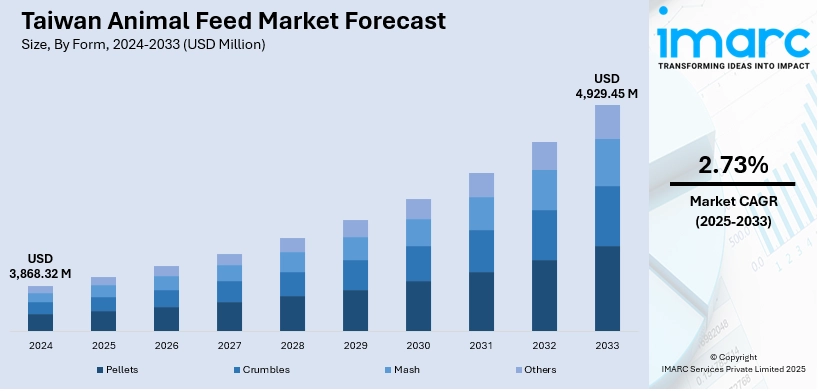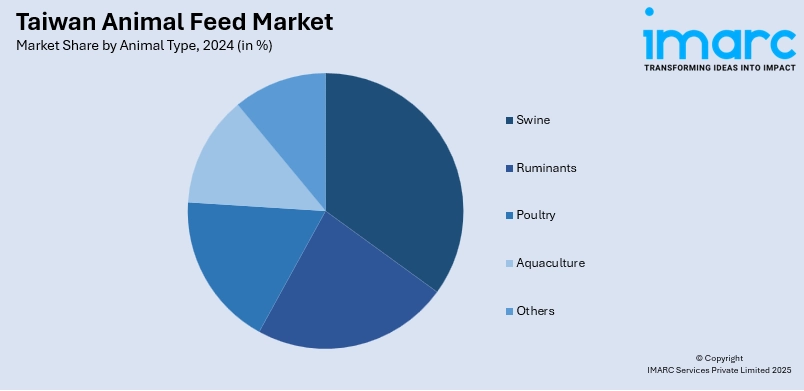
Taiwan Animal Feed Market Size, Share, Trends and Forecast by Form, Animal Type, Ingredient, and Region, 2025-2033
Taiwan Animal Feed Market Overview:
The Taiwan animal feed market size reached USD 3,868.32 Million in 2024. The market is projected to reach USD 4,929.45 Million by 2033, exhibiting a growth rate (CAGR) of 2.73% during 2025-2033.The market is expanding due to increasing demand for high-performance livestock nutrition and greater focus on animal health management. In addition, rising use of sustainable feed ingredients and advanced formulations continues to support Taiwan animal feed market share across poultry, swine, and dairy sectors.
|
Report Attribute
|
Key Statistics
|
|---|---|
|
Base Year
|
2024
|
|
Forecast Years
|
2025-2033
|
|
Historical Years
|
2019-2024
|
| Market Size in 2024 | USD 3,868.32 Million |
| Market Forecast in 2033 | USD 4,929.45 Million |
| Market Growth Rate 2025-2033 | 2.73% |
Taiwan Animal Feed Market Trends:
Rising Demand for Quality Nutrition
In recent years, livestock producers in Taiwan have shown a growing preference for high-quality and nutrient-rich feed. This shift is driven by the rising awareness of animal health, better productivity, and food safety concerns. Consumers are more conscious about the source and quality of meat and dairy products, prompting feed manufacturers to improve formulations. The use of additives like amino acids, vitamins, and minerals is increasing to meet the nutritional demands of animals and ensure disease resistance. Another factor contributing to this trend is Taiwan's limited agricultural land, which leads to a reliance on efficient feed to maximize livestock output. These developments are fueling the Taiwan animal feed market growth, with both local companies and international players investing in innovative feed blends. Imports of specialized feed ingredients have also risen, indicating the sector’s transition toward value-added products. As producers look to reduce mortality rates and improve growth cycles, feed plays a more central role in farm management strategies. Moreover, changes in dietary preferences among end consumers are impacting feed formulations. Higher demand for leaner meats and dairy quality leads to careful control of livestock nutrition. The increasing emphasis on scientific feeding methods, particularly in swine and poultry segments, further boosts demand for specialized feed solutions across Taiwan.

To get more information on this market, Request Sample
Shift Towards Sustainable Ingredients
Sustainability is becoming an essential driver in Taiwan’s animal feed sector. With increasing pressure to reduce environmental impact, companies are exploring alternative ingredients such as algae, insect protein, and plant-based by-products. These alternatives not only offer comparable nutritional value but also help lower greenhouse gas emissions associated with traditional feed production. The government’s support for eco-friendly agricultural practices further encourages the adoption of these sustainable feed sources. Additionally, advancements in feed processing technology make it easier to include non-conventional ingredients without compromising on quality. Feed mills are optimizing their operations to reduce waste and energy consumption, aligning with Taiwan’s broader environmental goals. This trend is also influenced by global supply chain risks, prompting companies to seek local, renewable raw materials. As Taiwan imports a significant portion of its feed grains, developing alternative supply chains offers long-term resilience and cost control. Farmers are increasingly aware of the benefits of sustainable practices not only for the environment but also for animal well-being and product quality. Certification programs and retailer pressure are pushing producers to adopt traceable and responsible feed sources. Over time, the demand for sustainability is expected to grow, shaping how feed is developed, marketed, and regulated across Taiwan's animal farming sector.
Taiwan Animal Feed Market Segmentation:
IMARC Group provides an analysis of the key trends in each segment of the market, along with forecasts at the country and regional level for 2025-2033. Our report has categorized the market based on form, animal type, and ingredient.
Form Insights:
- Pellets
- Crumbles
- Mash
- Others
The report has provided a detailed breakup and analysis of the market based on the form. This includes pellets, crumbles, mash, and others.
Animal Type Insights:

- Swine
- Starter
- Finisher
- Grower
- Ruminants
- Calves
- Dairy Cattle
- Beef Cattle
- Others
- Poultry
- Broilers
- Layers
- Turkeys
- Others
- Aquaculture
- Carps
- Crustaceans
- Mackeral
- Milkfish
- Mollusks
- Salmon
- Others
- Others
The report has provided a detailed breakup and analysis of the market based on the animal type. This includes swine (starter, finisher, and grower), ruminants (calves, dairy cattle, beef cattle, and others), poultry (broilers, layers, turkeys, and others), aquaculture (carps, crustaceans, mackeral, milkfish, mollusks, salmon, and others), and others.
Ingredient Insights:
- Cereals
- Oilseed Meal
- Molasses
- Fish Oil and Fish Meal
- Additives
- Antibiotics
- Vitamins
- Antioxidants
- Amino Acids
- Feed Enzymes
- Feed Acidifiers
- Others
- Others
The report has provided a detailed breakup and analysis of the market based on the ingredient. This includes cereals, oilseed meal, molasses, fish oil and fish meal, additives (antibiotics, vitamins, antioxidants, amino acids, feed enzymes, feed acidifiers, and others), and others.
Regional Insights:
- Northern Taiwan
- Central Taiwan
- Southern Taiwan
- Eastern Taiwan
The report has also provided a comprehensive analysis of all the major regional markets, which include Northern Taiwan, Central Taiwan, Southern Taiwan, and Eastern Taiwan.
Competitive Landscape:
The market research report has also provided a comprehensive analysis of the competitive landscape. Competitive analysis such as market structure, key player positioning, top winning strategies, competitive dashboard, and company evaluation quadrant has been covered in the report. Also, detailed profiles of all major companies have been provided.
Taiwan Animal Feed Market News:
- April 2025, AgriLivestock and Feed Taiwan announced its upcoming event focused on advanced feeding systems, AI-driven farm management, and sustainable livestock practices. It strengthened Taiwan’s animal feed market by promoting precision technologies and fostering global partnerships, improving efficiency and boosting international trade engagement.
- March 2025, VIV Asia showcased advanced feed ingredients, animal nutrition technologies, and farm management solutions in Bangkok. With participation from Taiwan and 45 other countries, the event supported innovation in animal feed, fostering regional partnerships and driving sustainable growth in the Asia-Pacific feed market.
Taiwan Animal Feed Market Report Coverage:
| Report Features | Details |
|---|---|
| Base Year of the Analysis | 2024 |
| Historical Period | 2019-2024 |
| Forecast Period | 2025-2033 |
| Units | Million USD |
| Scope of the Report |
Exploration of Historical Trends and Market Outlook, Industry Catalysts and Challenges, Segment-Wise Historical and Future Market Assessment:
|
| Forms Covered | Pellets, Crumbles, Mash, Others |
| Animal Types Covered |
|
| Ingredients Covered |
|
| Regions Covered | Northern Taiwan, Central Taiwan, Southern Taiwan, Eastern Taiwan |
| Customization Scope | 10% Free Customization |
| Post-Sale Analyst Support | 10-12 Weeks |
| Delivery Format | PDF and Excel through Email (We can also provide the editable version of the report in PPT/Word format on special request) |
Key Questions Answered in This Report:
- How has the Taiwan animal feed market performed so far and how will it perform in the coming years?
- What is the breakup of the Taiwan animal feed market on the basis of form?
- What is the breakup of the Taiwan animal feed market on the basis of animal type?
- What is the breakup of the Taiwan animal feed market on the basis of ingredient?
- What is the breakup of the Taiwan animal feed market on the basis of region?
- What are the various stages in the value chain of the Taiwan animal feed market?
- What are the key driving factors and challenges in the Taiwan animal feed market?
- What is the structure of the Taiwan animal feed market and who are the key players?
- What is the degree of competition in the Taiwan animal feed market?
Key Benefits for Stakeholders:
- IMARC’s industry report offers a comprehensive quantitative analysis of various market segments, historical and current market trends, market forecasts, and dynamics of the Taiwan animal feed market from 2019-2033.
- The research report provides the latest information on the market drivers, challenges, and opportunities in the Taiwan animal feed market.
- Porter's Five Forces analysis assists stakeholders in assessing the impact of new entrants, competitive rivalry, supplier power, buyer power, and the threat of substitution. It helps stakeholders to analyze the level of competition within the Taiwan animal feed industry and its attractiveness.
- Competitive landscape allows stakeholders to understand their competitive environment and provides an insight into the current positions of key players in the market.
Need more help?
- Speak to our experienced analysts for insights on the current market scenarios.
- Include additional segments and countries to customize the report as per your requirement.
- Gain an unparalleled competitive advantage in your domain by understanding how to utilize the report and positively impacting your operations and revenue.
- For further assistance, please connect with our analysts.
 Request Customization
Request Customization
 Speak to an Analyst
Speak to an Analyst
 Request Brochure
Request Brochure
 Inquire Before Buying
Inquire Before Buying




.webp)




.webp)












